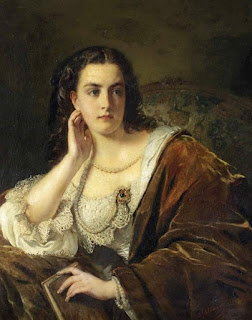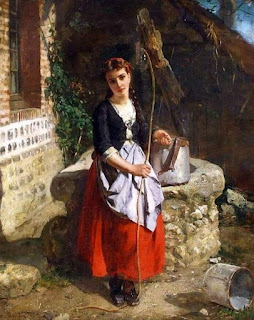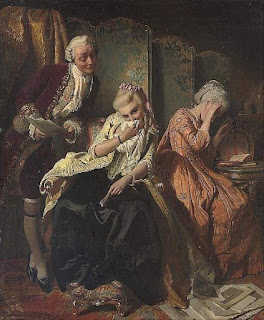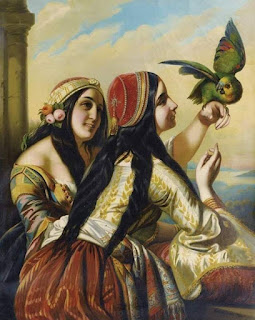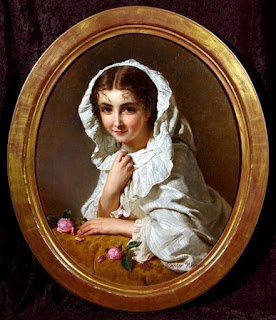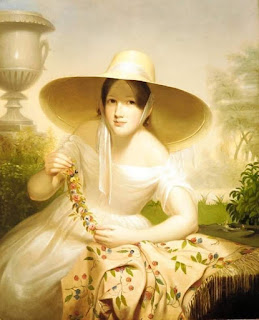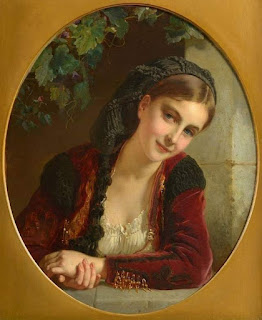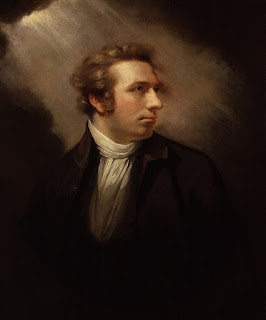ولد في سويسرا الثاني لثمانية عشر طفل، والده كان يوهان كاسبر فوسلي، رسام بورتريهات ومناظر طبيعية، أرسل هنري للكنيسة، ثم لكلية كارولين في زيورخ حيث تلقي تعليم ممتاز عن الفن التقليدي "الكلاسيكي" أحد زملائه هناك كان يوهان لافاتير، حيث أصبحا صديقين مقربين.
أجبر هنري على مغادرة البلاد عام 1761 بعد أن ساعد صديقه يوهان لافاتير على فضح أحد القضاة الفاسدين، حيث سعت عائلة القاضي القوية للثأر منه. كان سفره الأول في أنحاء ألمانيا، وفي عام 1765 زار إنجلترا، حيث ساند نفسه لبعض الوقت بكتابات شتى. في أخر الأمر تعرف على جوشوا رينولدز أحد أبرز رسامين القرن الثامن عشر، حيث عرض عليه لوحاته، وبإتباع نصيحة جوشوا رينولدز كرس نفسه للرسم. في عام 1770 سافر إلي إيطاليا لدراسة الفن، حيث عكف فيها إلى عام 1778، وغير اسمه من Füssli إلى Fuseli لأنها كانت "أكثر إيطالية".
مؤخراً عام 1779 عاد لبريطانيا، مارا بزيوريخ في طريقه، وأبدع بعض اللوحات الشهيرة لمسرحيات وليم شكسبير، في عام 1788 تزوج صوفيا رولينس "كانت في الأصل أحد النماذج التي قام برسمها"، ألتحق بالمعهد الملكي، بعد ذلك بعامين رقي ليكون أكاديميا.
Biography of Henry Fuseli
Childhood
Johann Heinrich Füssli (known as Henry Fuseli) was born in Zürich on February 7th, 1741. He was the second of 18 children born to the Swiss portrait painter, Johann Caspar Füssli and his wife, Anna Elisabeth Waser. Caspar was a collector of sixteenth and seventeenth century Swiss art and passed his appreciation of fine art onto his son. Indeed, Fuseli's father introduced him to the ideas of the art historian Johann Joachim Winckelmann and the German painter Anton Raphael Mengs both of whom shared an enthusiasm for classical antiquity and an unwavering commitment to the values of Neoclassical painting.
Study for Self-portrait (1780s), Drawing, Black and White chalk on paper, Victoria and Albert Museum, London
Fuseli spent many hours making sketches of the drawings in his father's collection, a practice he continued well into his teens. His father, somewhat surprisingly given his own profession, disapproved of Fuseli's artistic ambitions. He decreed that his son should train to become a Minister of the Church and arranged for him to obtain a classical education at the Caroline College of Zürich. Once enrolled, Fuseli studied with the influential literary critics J.J. Breitinger and J.J. Bodmer who between them introduced him to the literary works of Milton and Shakespeare. Bodmer was also an early champion of Fuseli's interest in painting. It was while at Caroline College that Fuseli met Johann Kaspar Lavater, the Swiss poet and theologian, with whom he formed a close and lasting friendship.
Early Training and Work
Fuseli was ordained as a priest in 1761. However, he was forced to leave Switzerland soon thereafter for helping Lavater expose a corrupt and vengeful magistrate. He crossed the border into Germany where he fell under the influence of the German Enlightenment, a philosophical movement which dominated European thought during the eighteenth century. The movement promoted the idea of reason to determine legitimate authority and became the precursor of ideas such as freedom and tolerance, and most significantly for Fuseli, the separation of church and state.
In 1764 Fuseli moved to London where he worked as a translator of French, German and Italian books. His first major translation was J. J. Winkelmann's Reflections on the Painting and Sculpture of the Greeks, published in 1765. The German Neo-classicist was hailed by many as the "prophet and founding hero of modern archaeology" and the father of modern art history. Indeed, the volume was considered one of the first to introduce a systematic basis for the classification of art. Soon thereafter Fuseli translated a book on the French philosopher Jean-Jacques Rousseau, Remarks on the Writing and Conduct of J. J. Rousseau, published in 1767. It seems likely that his exposure to such influential Enlightenment philosophers prompted him to publicly declare himself a non-Christian.
While residing in London, Fuseli met Sir Joshua Reynolds, first president of the Royal Academy, to whom he showed his drawings. Reynolds admired the Swiss's draughtsmanship and encouraged him to further his studies in Italy. Arriving in Rome in 1770, Fuseli fell in with a like-minded group of English and Continental artists which included Alexander Runciman, Johan Tobias Sergei, and Nicolai Abildgaard. His studies took in the works of Michelangelo and the Mannerists, as well as Greek and Roman antiquities. His Roman studies would have a major influence on his later work, particularly in his ability to enhance the drama in his pictures by foreshortening figures and by using chiaroscuro and a means of distortion. It was while in Italy that he also changed his name from the German spelling of Füssli to the Italian, Fuseli; an act of deference (to Italy) that helped him assimilate with his newly adopted country. Despite his artistic studies, however, he remained devoted to literature, a passion which continued throughout his life.
Mature Period
By 1773 Fuseli was already making a name for himself in Rome with a strong connection to the German proto-Romantic Sturm und Drang movement. Sturm und Drang lasted from the late 1760s to the early 1780s and championed the freedom of subjective expression over the rationalism that had helped define the new era of Enlightenment. Goethe, a protagonist of the movement, and admirer and collector of his drawings, saw Fuseli as the visual embodiment of the movement, saying of his art: "What fury the man has in him".
While in Rome, Fuseli fell passionately in love with Anna Landolt, Lavater's niece who he met in 1778. Although unable to marry her due to her father's objection, he was obsessed by her, confiding erotic fantasies of her in a letter to Lavater. Fuseli would live and work in Rome for the next eight years before returning (following a short stay in Zürich) to London in 1779. Back in London he became a regular exhibitor at the Royal Academy.
In 1783 Fuseli exhibited his iconic painting, The Nightmare at the Royal Academy's Summer Exhibition. Engravings of this popular work were sold and provided an important boost to his reputation as an imaginative artist focussing on the psychological depiction of mental states. The publicity he gained from the commercial success of these engraving set Fuseli on a career of painting variations on this theme. Although occupied with new commissions and exhibitions, Fuseli continued his translation work. In 1778, he published an English translation of Lavater's influential book on physiognomy, Physiognomische Fragmente zur Beförderung der Menschenkenntnis und Menschenliebe and assisted the English poet, William Cowper, in his translation of Homer. He also wrote for the radical English periodical, The Analytical Review that included controversial thinkers of the day including Mary Wollstonecraft, best known for her book A Vindication of the Rights of Woman (1792); Thomas Malthus, famous for his population theory; and Joseph Priestly, to whom the discovery of oxygen was attributed.
Sophia Rawlins, the artist's wife, by Henry Fuseli, (Late 18th Century)
In 1788, the same year he was elected an Associate of the Royal Academy (becoming a full Academician two years later), Fuseli met Sophia Rawlins at an exhibition at the Society of Artists. They were soon married, and Fuseli would regularly use his wife, widely known for her near obsession with hair and fashion, as a model (he is known to have painted over 150 portraits of her). Although they had no children, theirs was known to be a very passionate, even fetishistic, relationship, and she sat for a series of erotic pictures, many of which she destroyed immediately following her husband's death. A notorious lady's man, Fuseli is also reputed to have had a sexual relationship with Mary Wollstonecraft, the early feminist and mother of Frankenstein author Mary Shelley. Keen as he was to continue an open affair with Wollstonecraft, Rawlins stopped short of allowing her visits to their marital home.
Late Period
John Boydell, the eminent engraver and publisher of the period, commissioned a number of important artists, including Sir Joshua Reynolds, to illustrate scenes from Shakespeare with the goal of producing an illustrated companion for his plays. Fuseli, who had fallen in love with the London Theatre, and especially the plays of Shakespeare, contributed a total of nine paintings, including three inspired by A Midsummer Night's Dream. The publication of the folio was however fraught with delays, and the public criticism of the finished work resulted in a commercial disaster. His love of Shakespeare undiminished, Fuseli produced a huge volume of illustrative work which included 85 paintings (five of which were exhibited at the Woodmason's Irish Gallery in Dublin), drawings, sketches and etchings.
In 1799, and inspired by Boydell's Shakespeare gallery, Fuseli opened the Milton Gallery in Pall Mall. Here he exhibited a series of 47 paintings inspired by the works of John Milton which he had painted over the previous nine years. The gallery opening was met with public and critical acclaim with The Morning Chronicle celebrating Fuseli's collected works as "an effort of genius almost equal to the Poet himself". Yet despite its critical success, the gallery flopped as a commercial enterprise and closed within the year.
Also in 1799, Fuseli was appointed Professor of Painting at Britain's oldest dedicated art school, the affiliated Royal Academy Schools, where his teachings went on to inspire many who would become world renowned artists in their own right, such as J.M.W. Turner, Edwin Landseer and William Blake. On being elected Keeper of the Schools in 1804, Fuseli resigned his professorship, before being (re)appointed Professor of Painting in 1810. Henceforward he held both offices until his death (in 1825). Running parallel to his Schools duties, Fuseli made significant offerings to the theory and practice of art, publishing his book, Lectures on Painting in 1801, and contributing to Pilkington's Lives of the Artists published in 1805. (An extensive range of his writings on art were compiled posthumously by his friend, John Knowles in 1831.)
Meanwhile, in 1817, the Italian sculptor, and leading exponent of the Neoclassical style, Antonio Canova, returned to Rome following a visit to London where he was so impressed with Fuseli's work he supported his election as a member of the First Class in the Academy of St. Luke. Founded in 1577, this prestigious association of artists in Rome sought to elevate the stature of painting beyond that of mere craftmanship, and Fuseli's election to St. Luke cemented his reputation as one of the leading artists of the day. Fuseli died on April 16, 1825 in Putney, London, at the age of 84. He is buried in the crypt of St. Paul's Cathedral where eminent public figures are interred including the likes of Sir Joshua Reynolds and the architect Sir Christopher Wren.
The Legacy of Henry Fuseli
A successful artist in his own lifetime, the foundations of his legacy were put in place when his style was parodied by eminent satirists of the day including Thomas Rowlandson and James Gillray. Fuseli directly influenced a number of younger artists including William Blake, Theodor von Holst, the Pre-Raphaelite, Dante Gabriel Rossetti and, through the Royal Academy, eminent artists including J. M. W. Turner, John Constable and Sir Thomas Lawrence. His influence was carried into the twentieth century by the Surrealists who claimed him as a surrogate father. Indeed, the Surrealists paid direct homage to him as an artist who explored "One of the most unexplored regions of art is dreams" in their 1936 New York exhibition, Fantastic Art, Dada, Surrealism. Today his presence is kept alive in the work of contemporary artists such as Juliane Hundertmark.



